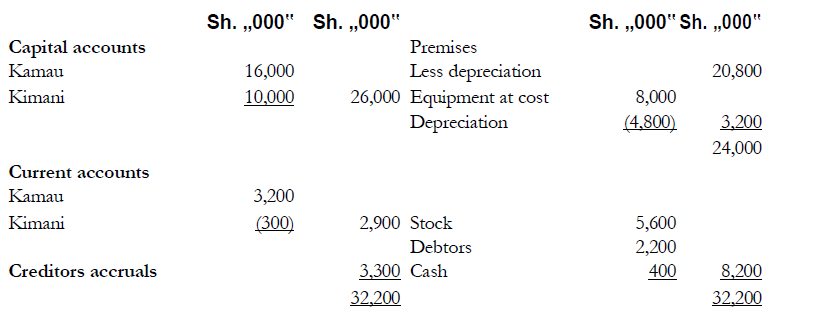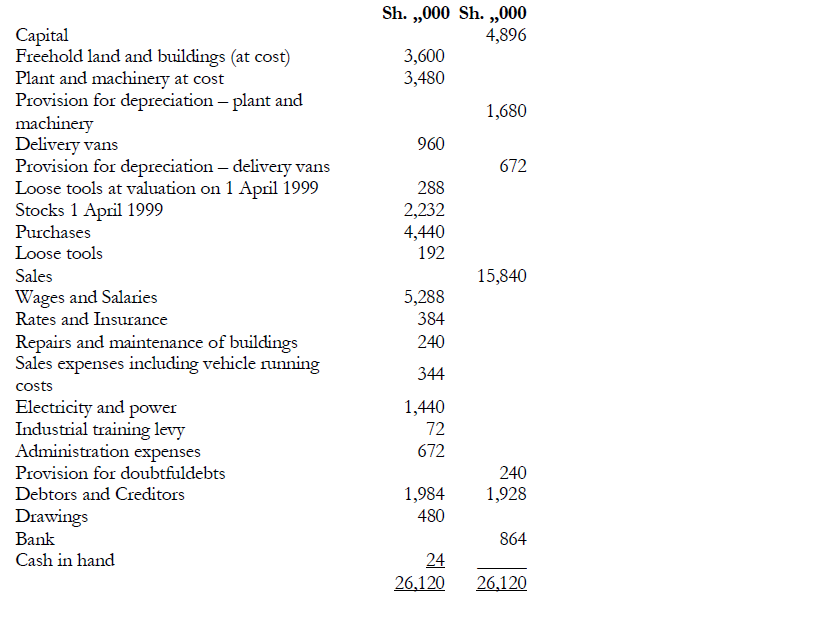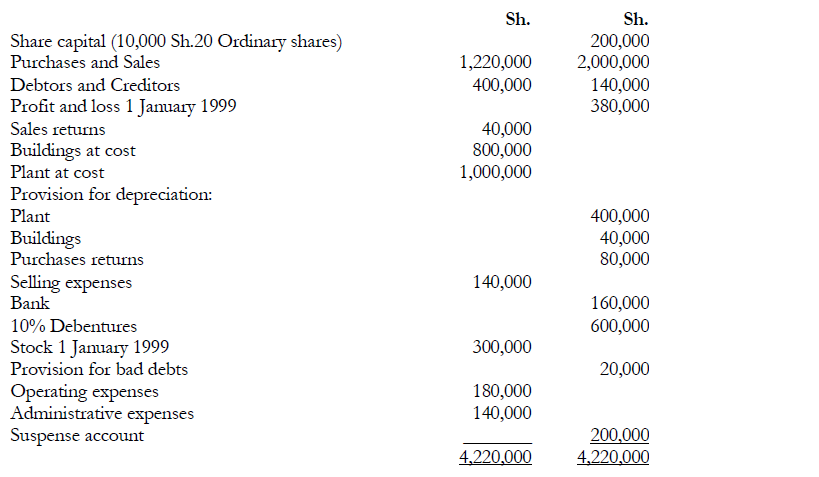Define the following accounting concepts and for each explain their implication in the preparation of financial Statements.
(i) The Going concern concept.
(ii) Business entity concept.
(iii) Materiality.
(iv)...
(Solved)
Define the following accounting concepts and for each explain their implication in the preparation of financial Statements.
(i) The Going concern concept.
(ii) Business entity concept.
(iii) Materiality.
(iv) Realisation.
Date posted:
November 16, 2018
.
Answers (1)
Kamau and Kimani are partners sharing profits and losses in the ratio 3:2 respectively. The
partnership agreement provides for Kimani to receive a salary of Sh.4,000,000...
(Solved)
Kamau and Kimani are partners sharing profits and losses in the ratio 3:2 respectively. The
partnership agreement provides for Kimani to receive a salary of Sh.4,000,000 per annum, and
interest on capitals for both partners at 5% per annum. The partnership balance sheet as at 31
December 1998 was as follows:

On I April 1999 Kimata was admitted to the partnership. He had been a salaried employee,
earning Sh.8, 000,000 per annum. The terms of his admission to the partnership were as
follows:
1. Kimata should introduce Sh. 12,000,000 in cash as capital into the business.
2. Goodwill should be valued at Sh.14, 000,000 for the purpose of his admission. It was
agreed that goodwill should not be included in the balance sheet of the new partnership.
3. Kimata should receive a salary as a partner of Sh.6 , 000,000 per annum.
Kimani's salary should be raised to Sh.6, 000,000.
4. Interest on capital should be raised from 5% to 6% per annum and calculated on the
capital accounts after the elimination of goodwill.
5. The new profit sharing ratio for Kamau, Kimani and Kimata should be 4:2:1
respectively.
In preparing the draft financial statements for the year ended 31 December 1999, the
partnership accountant, Otieno, calculated that the partnerships profit for the year was Sh.55,
155,000, and that the working capital of the business as at 31 December 1999 was:

Profit is assumed to accrue evenly during the year.
Partners cash drawings for the year were Kamau Sh.23,705,000, Kimani Sh.19,525,000 and
Kimata Sh.8,250,000.
Required:
(a) The profit and loss appropriation account for the year ended 3 1 December 1999.
(b) The current and capital accounts of the partners for the year ended 31 December
1999.
(c) Balance Sheet as at 31 December 1999.
Date posted:
November 16, 2018
.
Answers (1)
Mr. Ancentus Okwengo is the sole proprietor of a small business. The following trial balance
was extracted from his books at 31 March 2000.
(Solved)
Mr. Ancentus Okwengo is the sole proprietor of a small business. The following trial balance
was extracted from his books at 31 March 2000.

Additional information:
1. Closing stock on 3 1 March
2000 was Sh.2, 008,000.
Loose tools at valuation
Sh.384, 000.
2 .Provision is to be made for the following amount
owing on 3 1 March 2000: Electricity and power
Sh.192,000.
3. Payments in advance on 31 March
2000 were as follows: Van licenses
Sh.2,520 and rates Sh.13,800.
4. Depreciation on plant and machinery and delivery vans is to be provided at the rate of
20% and 25% respectively on cost at the end of the year.
5. Bad debts amounting to Sh.26,000 are to be written off and the provision for
doubtful debts is to be 10% of trade debtors.
Required:
A ten-column worksheet for the year ended 31 March 2000.
Date posted:
November 16, 2018
.
Answers (1)
The trial balance of Zach Ltd. as at 31 December 1999 was as follows:
(Solved)
The trial balance of Zach Ltd. as at 31 December 1999 was as follows:

Additional information:
1. Stock at 31 December 1999 was Sh.360,000.
2. Sales returns of Sh.20,000 have been entered in the sales day book as if they were sales.
When this error was discovered, the debtors account had been corrected but the sales figure
was not rectified.
3. 5000 new shares were issued during the year at Sh.32. The proceeds have been credited to
the suspense account.
4. A fully depreciated plant which cost Sh.200,000 was sold during the year. No other entries except
bank have been made. The remaining balance on the suspense account after (2 and 3) above
represents the sale proceeds.
5. A debtor of Sh.20,000 has been declared bankrupt. A general provision is required at 5% of
debtors.
6. Rates of Sh.30,000 paid in December covering half year to 31 March 2000 have not been
entered in the books.
7. Debenture interest has not been paid.
8. Depreciation on plant is at 10% on cost and buildings at 2% on cost.
9. The directors propose to pay a dividend of Sh.2 per share and transfer Sh.20,000 to the
general reserve.
10. Corporation tax at a rate of 32'/2% on profits is estimated to be Sh.90,000.
Required:
(a)Suspense account for the year ended 3I December 1999
(b)Trading,profit and loss account for the year ended 31 December 1999.
(c) Balance sheet as at 31 December 1999.
Date posted:
November 15, 2018
.
Answers (1)